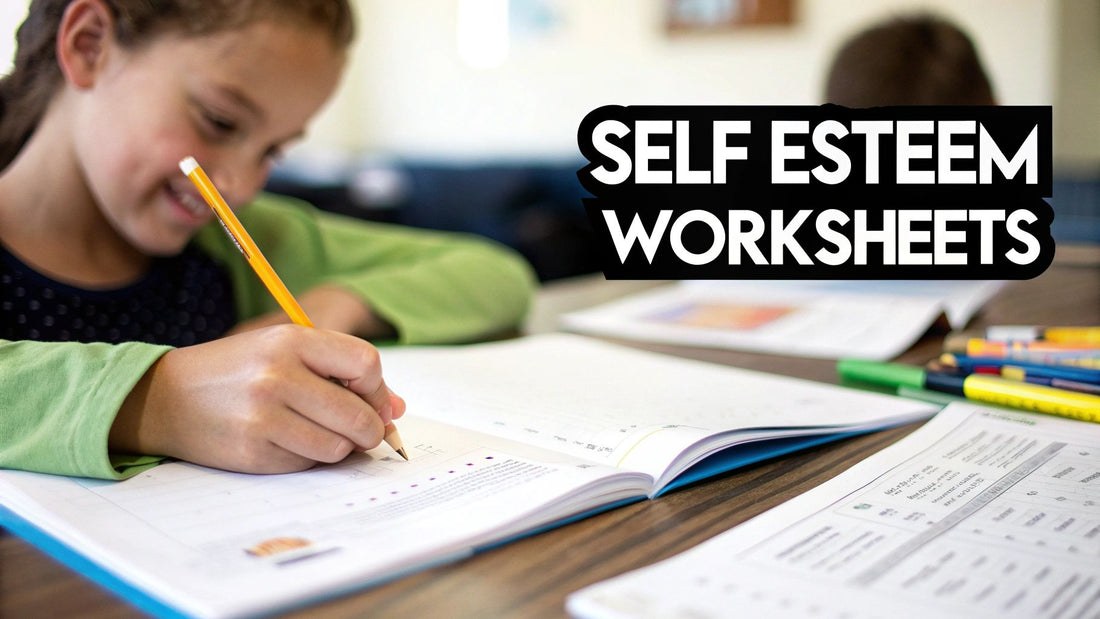
Worksheets for Self-Esteem: Boost Confidence in Kids & Teens
Share
Why Building Self-Esteem in UK Children Matters More Than Ever
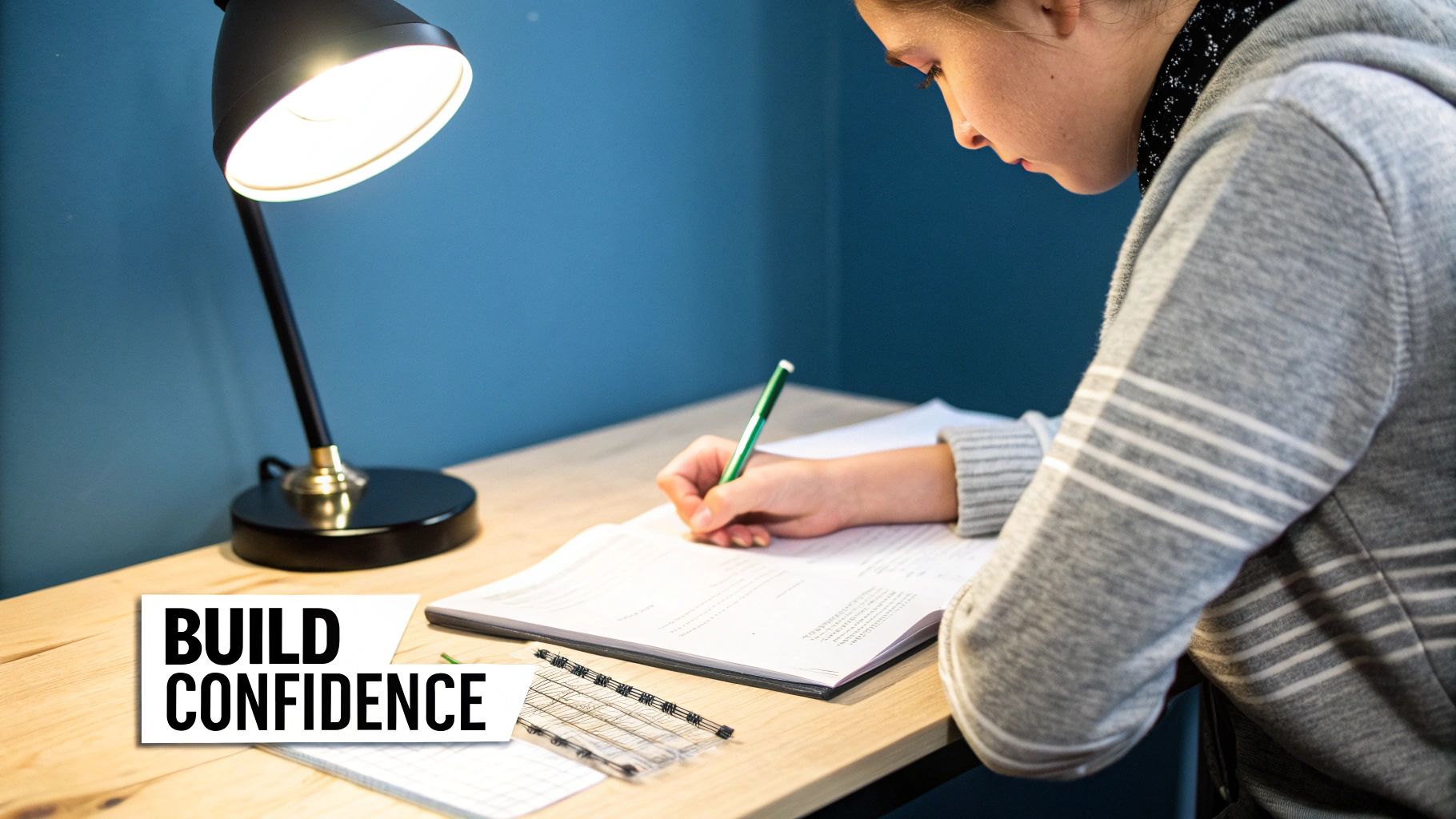
The conversation around children's mental health here in the UK has never felt more urgent. The latest findings from the NHS paint a sobering picture: in 2023, around one in five children and young people in England, aged 8 to 25, were dealing with a probable mental health condition. This isn't just a statistic; it's a clear signal that we need to be more proactive in supporting our kids. Addressing mental health early is crucial, as it lays the foundation for lifelong wellbeing and resilience.
Low self-esteem often sits right at the heart of these struggles. Think of it as a shaky foundation – it’s hard to build anything sturdy on top of it. Our children are navigating a world brimming with unique pressures, from the weight of academic expectations to the endless, curated highlight reels on social media, all of which can quietly chip away at their sense of self-worth.
The Modern Pressures on Young Minds
There’s no denying the impact of modern life on a child's confidence. The digital world connects us, yes, but social media also creates an environment where comparison is constant and inescapable. Unlike playground squabbles, cyberbullying can follow a child right into their own bedroom, making it incredibly difficult to build a stable, positive self-image.
On top of this, academic pressure can trick children into tying their entire worth to their grades. We believe that nurturing a child's inner strength is far more important than focusing only on exam results. It’s a philosophy that recognises why confidence is more important than grades – it’s the true bedrock for a happy and successful future.
Addressing low self-esteem early isn't just about making a child feel better today. It's about equipping them with the resilience they'll need to navigate all of life's ups and downs.
The Long-Term Impact
The ripples of poor self-esteem in childhood can travel far into adult life. It's not just a personal issue; it has a wider impact. According to Deloitte, poor mental health costs UK businesses an estimated £56 billion a year through lost productivity and staff turnover. When we build a strong sense of self in our children, we are truly investing in a healthier, more capable future generation.
This is where tools like worksheets for self esteem come in. They aren't just a 'nice-to-have'; they are an essential part of the modern toolkit for any parent or educator. They offer a simple, structured way to start important conversations about feelings and build that crucial foundation of resilience. For more practical ideas, you can also explore our guide on how to support your child’s mental health.
Disclaimer: Please remember, I am not a mental health professional. This guide provides information and support, not medical advice. If you have serious concerns about your child's mental health, please consult a doctor or a qualified healthcare provider.
How Self-Esteem Worksheets Build Real Confidence
So, what exactly are self-esteem worksheets? Let's clear up any confusion right away. These aren't just another bit of homework or a chore to be ticked off a list. Think of them more like a 'mental fitness routine' – a series of structured, gentle exercises designed to build up a child's inner strength and resilience. They work by taking abstract feelings and turning them into concrete thoughts and actions a child can actually see and work with.
Picture a child's mind as a tangled ball of yarn, a jumble of confusing emotions and self-critical thoughts. A good worksheet acts as a patient guide, helping them gently unravel one thread at a time. It creates a safe, quiet space for them to explore how they feel, completely free from judgement.
Turning Thoughts into Strengths
At their heart, these worksheets guide a child on a journey of self-discovery. They use simple prompts and activities that get children to properly engage with their own thoughts and feelings, helping to build genuine, lasting confidence from the inside out.
For example, a 'strength spotting' exercise might ask a child to list things they're good at. It could be anything from being a kind friend to finally beating a tricky level on a video game. Another popular activity is creating a 'positive affirmation jar', where they write down positive things about themselves. These small, consistent actions start to reshape their inner narrative, helping them truly internalise their own worth.
Here in the UK, these kinds of structured activities are increasingly recognised as powerful mental health tools. Specific exercises, from positive goal setting to motivational jars, are designed to boost teen confidence by focusing on building competence, resilience, and optimism. You can discover more about activities for teen self-esteem and see just how effective they can be.
Seeing the Positive Changes
When a child uses these resources consistently, the impact can be genuinely profound. You start to see noticeable, positive shifts in their behaviour and mindset as they nurture a kinder inner voice.
This chart here really brings to life the positive outcomes that come from using structured self-esteem activities.
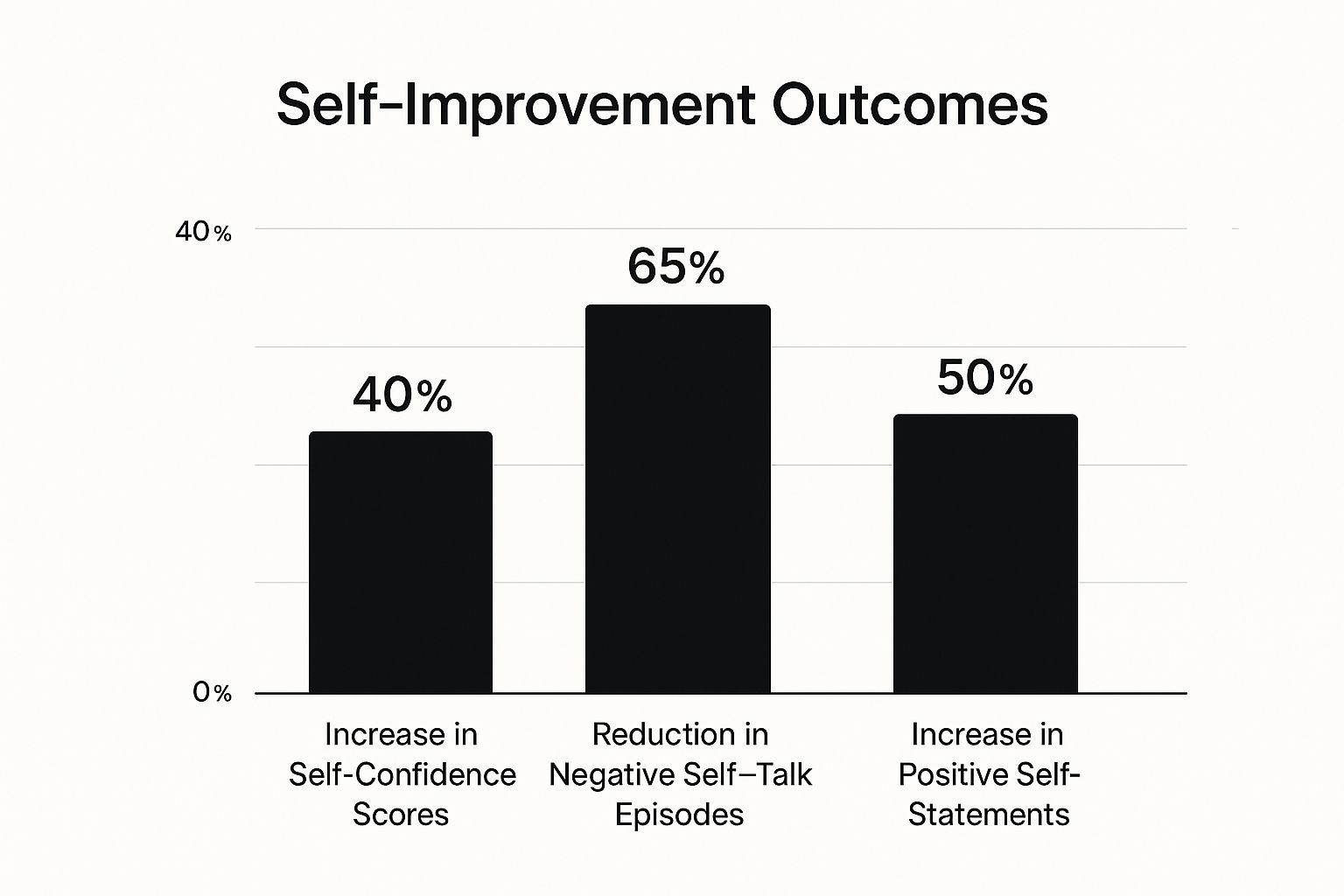
As the data makes clear, sticking with these simple exercises leads to some amazing improvements. We're talking a 65% reduction in negative self-talk and a real, measurable jump in self-confidence scores. It’s solid proof of how these simple worksheets translate into tangible emotional growth. By giving children a framework to challenge unhelpful thoughts and celebrate their wins, no matter how small, these worksheets empower them to build a healthier relationship with themselves, one page at a time.
Using Self-Esteem Worksheets Effectively at Home
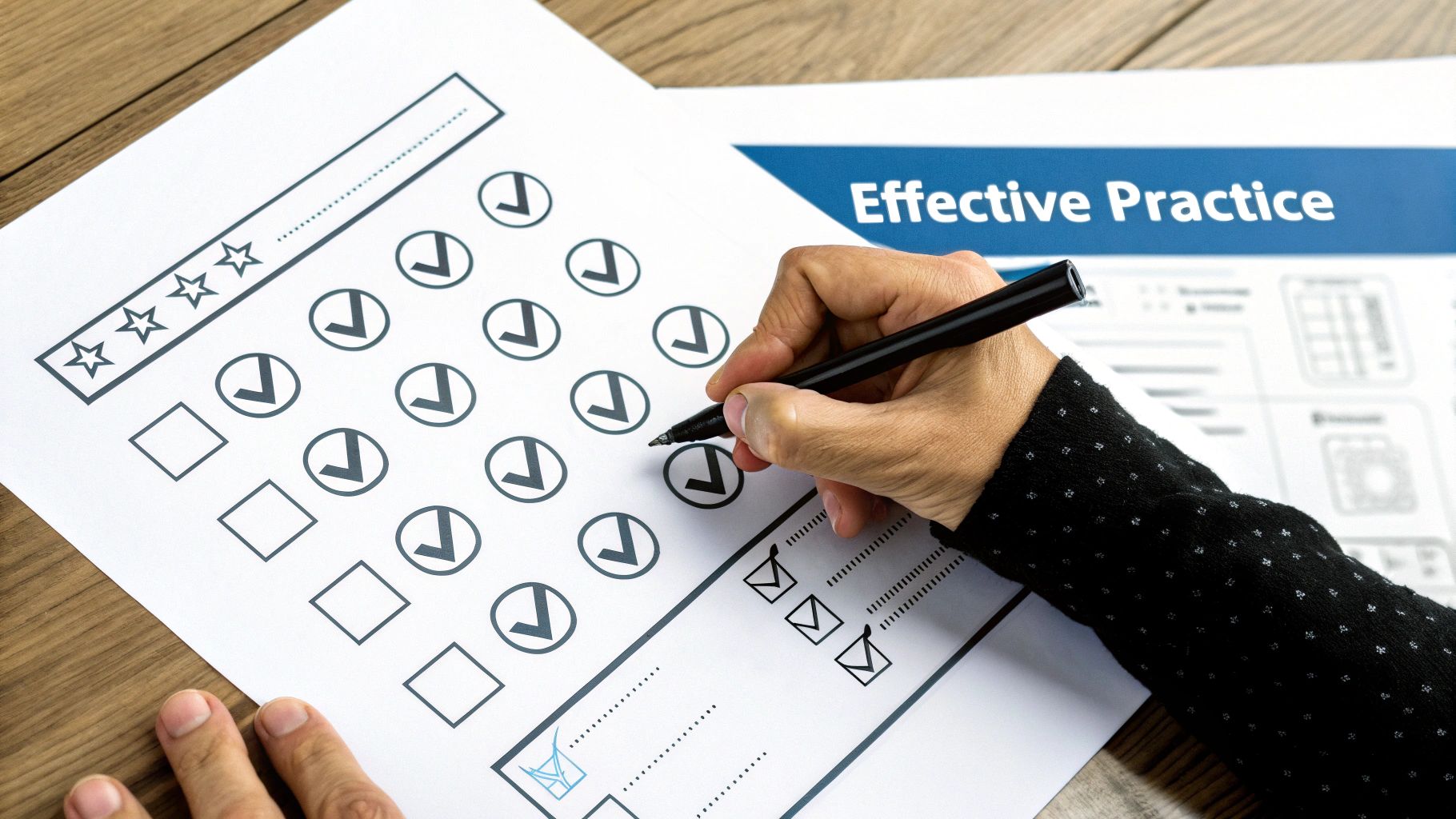
Bringing worksheets for self-esteem into your home doesn't have to feel like another piece of homework. The secret is to introduce them not as a chore, but as a special moment for connection. By creating a relaxed, supportive space, you can turn these simple pages into a powerful tool for building confidence.
Think of it as setting aside dedicated 'wellbeing time'. This could be a cosy ten minutes after dinner or a quiet Sunday afternoon activity. The real goal is to make it feel collaborative and fun, showing your child you’re on this journey together, exploring feelings side-by-side.
Making It a Positive Experience
How you frame the activity makes all the difference, especially if you have a reluctant child. Instead of presenting it as work, try framing it as a fun challenge or a creative project we can do together. Get out the colourful pens and stickers, and turn it into a chance for them to express themselves without any pressure.
You could say something like, "Let's be feelings detectives and find all the amazing things about you," or "How about we draw what our worries look like and pop them in this box?" This simple shift in approach transforms a worksheet into a playful, engaging experience.
Here are a few practical ideas to get you started:
- The 'Proud Moments' Jar: At the end of each week, spend a few minutes filling out a worksheet about something they felt proud of. For example: "This week, I was proud when I helped my friend tidy up." Fold it up and add it to a special jar.
- The 'Worry Box' Sheet: Before bedtime, use a worksheet to help them write or draw any anxieties. Physically placing the paper into a 'worry box' can be a powerful ritual to help ease their mind for sleep.
- Strength-Spotting Together: Complete a worksheet that identifies strengths, but do it for each other. You could write, "I think you are really brave for trying the big slide," which not only builds their self-esteem but strengthens your family bond, too.
Practical Tips for Success
Remember, consistency is far more important than intensity. Short, regular sessions are much more impactful than one long, overwhelming one. The objective isn't just to complete a worksheet; it's to open up conversations about emotions and self-worth. It’s about creating a safe space for them to be vulnerable.
The most important part of this process is to listen without judgement. Let your child lead the way and simply be a supportive presence, validating their feelings and celebrating their unique qualities.
This approach doesn't just help build their confidence—it deepens your connection. For more guidance on this, our article offers some effective strategies for providing youth emotional support, helping you nurture a resilient and happy young mind.
Bringing Self-Esteem Activities into the Classroom
While home is where it starts, the classroom is another key place where a child's sense of self is shaped day in and day out. Bringing worksheets for self-esteem into school isn’t about piling more work onto an already packed timetable. Think of it more like weaving wellbeing into the very fabric of school life.
These kinds of resources fit hand-in-glove with the UK's PSHE (Personal, Social, Health and Economic) curriculum, which is all about helping young people become resilient and confident. By using these tools, teachers can create a structured, warm environment where pupils learn to value not just themselves, but each other too. It's a simple way to build a more positive and supportive atmosphere for everyone.
Fostering a Supportive Classroom Culture
Using self-esteem worksheets in a group can be an incredibly powerful experience. It’s a chance for pupils to see and celebrate their own strengths, and just as importantly, the strengths of their classmates. This shared activity is fantastic for breaking down barriers and building a real culture of kindness and respect.
For example, imagine an activity where children write down one positive quality for every person in their group. It sounds simple, but this creates a ripple effect of positivity that can change the whole dynamic of a classroom. It helps children see themselves through their friends' eyes, often uncovering strengths they never even knew they had.
Initiatives across the UK have already shown just how much of an impact these activities can have, improving both self-confidence and resilience. Schools using these resources often report significant jumps in how confident their students feel—sometimes by as much as 20% after regular use. You can learn more about how these resources build self-confidence and support pupils as they grow.
Identifying Needs and Improving Engagement
There’s another crucial role these activities play. They act as a gentle, subtle way for teachers to spot which pupils might be struggling quietly and need a bit of extra support. A child’s answers on a worksheet can offer a real window into their mindset, allowing for early and sensitive intervention.
By fostering a safe space for emotional expression, educators empower pupils to build the inner resources they need to thrive, both academically and personally.
At the end of the day, the link between self-worth and how a child does at school is crystal clear. When children feel good about themselves, they’re far more likely to put their hand up in class, take on new challenges, and stick with things when they get tricky.
Higher self-esteem leads directly to better classroom dynamics and children who are more engaged with their learning. It’s what makes worksheets for self-esteem such a vital tool for any modern classroom.
Expanding Your Toolkit Beyond Worksheets
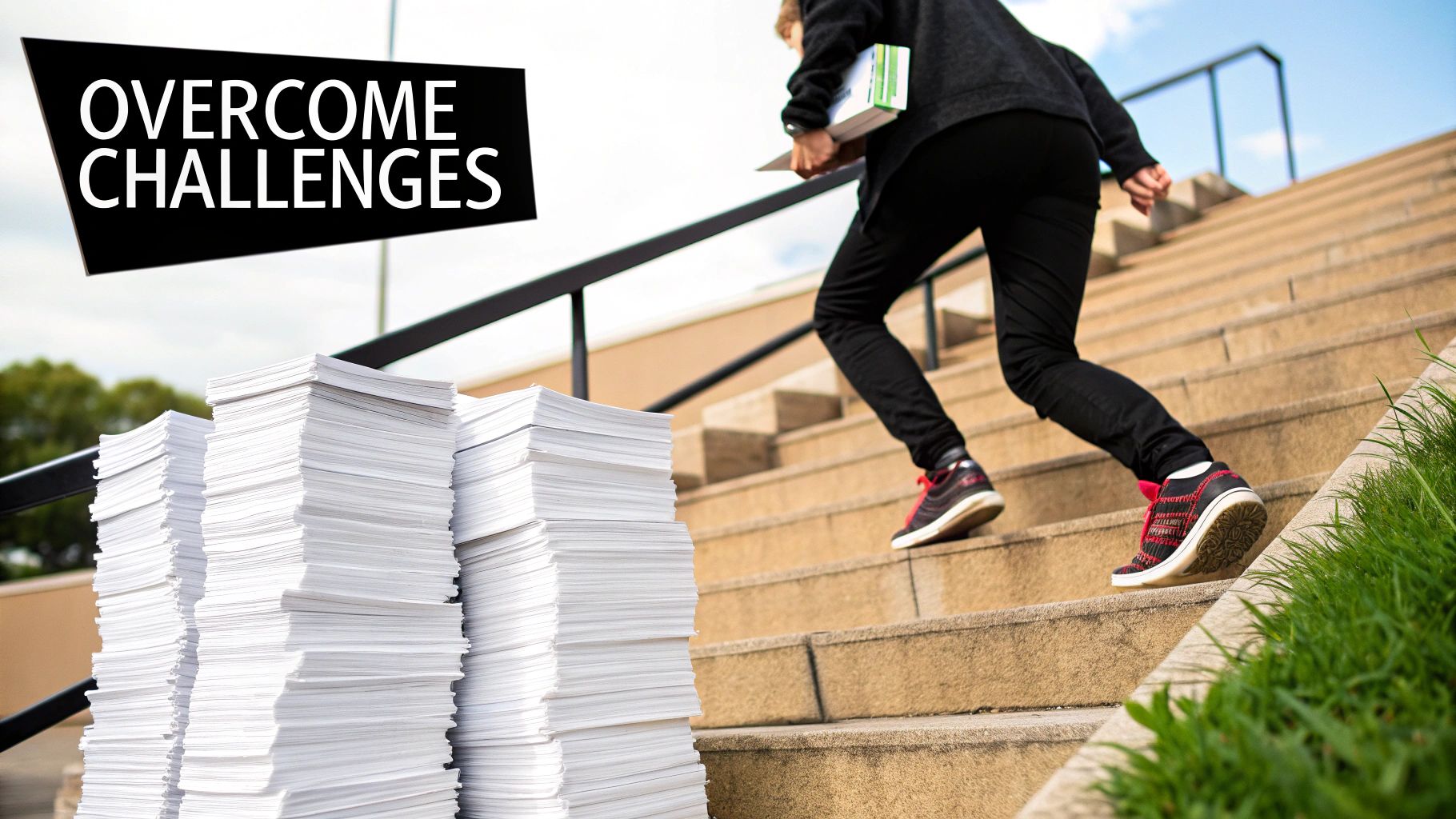
While worksheets for self esteem are a fantastic tool, they work best when they're part of a bigger picture. Think of them as one important piece of a well-rounded toolkit for mental wellbeing, where every resource you add makes the others even stronger.
True, lasting confidence isn't built in a single session; it's nurtured through a mix of daily practices and positive influences. This more holistic approach weaves small, positive actions right into the fabric of everyday life. From the stories children read to the clothes they wear, every little thing can help reinforce a positive self-image and offer comfort when they hit a rough patch.
Curated Resources for Positive Growth
Building out this support system doesn't have to be a huge, complicated task. Sometimes, a few carefully chosen resources can make all the difference in helping a child feel seen, understood, and confident in who they are.
Here are a few ideas to use alongside your worksheets:
-
Mental Health Books: Stories are just a wonderful way to explore big feelings in a safe space. Finding age-appropriate books that touch on themes like resilience, self-acceptance, and managing emotions can offer real comfort and some valuable life lessons. To get you started, have a look at our fantastic list of children's books recommendations.
-
Mental Health Apparel: It might sound simple, but what we wear can genuinely influence how we feel. Clothing with positive affirmations or gentle reminders to be kind to oneself can act as a wearable confidence booster—a quiet, personal source of strength they can carry with them all day.
-
Relaxation and Mindfulness: Teaching simple relaxation techniques is an invaluable skill. Just a few minutes of guided deep breathing (like 'box breathing': breathe in for 4, hold for 4, out for 4, hold for 4) or using a calming mindfulness app can help a child reset their nervous system and get a handle on those overwhelming feelings. A simple body scan, where they lie still and focus on how each part of their body feels, can also be incredibly grounding.
Important Note: I am not a mental health professional. The advice and resources shared here are for informational purposes only. If you have serious concerns about your child's wellbeing, please seek guidance from a doctor or a qualified healthcare provider.
Specialised Support and Final Thoughts
When you're adding to your toolkit, it's also worth looking into specialised tools that can help with specific learning challenges. Tackling these issues head-on can dramatically boost a child's confidence and create a much more positive experience with learning. For example, understanding how Text-to-Speech apps assist children with dyslexia can be a real game-changer for their academic self-esteem.
Ultimately, building self-worth is a journey, not a destination. By combining structured activities like worksheets with a rich tapestry of books, mindfulness, and even affirming apparel, you create a complete support system. This multi-faceted approach helps a child feel supported from all angles, empowering them to build a foundation of resilience that will last a lifetime.
Frequently Asked Questions About Self-Esteem Worksheets
Dipping your toes into the world of emotional wellbeing can bring up a lot of questions. We get it. Here are some clear, straightforward answers to the things parents and educators ask us most about using self-esteem worksheets. Our goal is to help you feel confident and ready to get started.
What Is the Best Age to Start Using These Worksheets?
Honestly, there’s no single “perfect” age. Every child develops at their own pace. You can introduce very simple, picture-based activities to children as young as four or five, just to get conversations about feelings started. For more structured worksheets that involve writing, children aged seven and up usually get the most out of them.
The real key is to match the worksheet's complexity to the child's developmental stage. For younger kids, think drawing and simple matching games. For older children and teens, you can dive into more reflective prompts about their strengths, challenges, and goals.
In the UK, self-esteem is rightly seen as a cornerstone of a child's mental health and social development. We know that low self-esteem can significantly increase the risk of mental health struggles later on, which makes early support so vital. That's why programmes using worksheets self esteem tools are becoming more common in UK schools, aiming to build a positive self-concept from a young age. You can find more great insights on building self-esteem in young people at plprimarystars.com.
How Can I Adapt Activities for Different Personalities?
Children are wonderfully unique, aren't they? What works for one might completely miss the mark with another. The trick is to tailor the activity to your child’s personality so it feels like a positive, enjoyable experience.
Here are a few ideas to get you thinking:
- For the Creative Child: Let them draw their feelings! They could create a collage of their strengths or even write a short story about a time they felt really proud of themselves.
- For the Quiet, Reflective Child: They might prefer worksheets with gentle, thought-provoking prompts they can mull over on their own before sharing their thoughts with you.
- For the Active, Energetic Child: Turn it into a game. How about a 'strength scavenger hunt' where they have to find examples of their positive qualities in their actions throughout the day?
The goal is always to make it feel engaging, never like a chore. Let their natural personality lead the way.
What Should I Do If My Child Is Resistant?
First off, don't panic. Resistance is perfectly normal. If a child pushes back, the most important thing is to avoid turning it into a battle. Forcing the issue will only create a negative feeling around talking about emotions.
Instead, take a step back and try a different angle. You could model the behaviour by filling out a worksheet yourself and leaving it where they might find it. Sometimes, just seeing you engage with it is enough to spark their curiosity.
Remember, the worksheet itself is just a tool. The real objective is to open a door to conversation. If the worksheet isn't working, simply ask open, gentle questions like, "What was the best part of your day today?"
Another great strategy is to connect the activity to their interests. If they're obsessed with superheroes, you could use a worksheet to explore what their own personal 'superpowers' (their strengths) are. Making it relevant and fun is the best way to melt away that initial reluctance.
How Do I Measure Progress in a Healthy Way?
It’s natural to want to see progress, but it’s crucial to remember that emotional growth isn’t a straight line. Unlike a maths test, there are no right or wrong answers, and progress will have its ups and downs.
Instead of looking for a "score," keep an eye out for small, qualitative changes.
- Are they using more positive language when they talk about themselves?
- Do they seem more willing to try new things, even if they're a bit nervous?
- Are they bouncing back from setbacks and disappointments a little quicker?
- Are they opening up and talking about their feelings with you more often?
These subtle shifts are the real signs of progress. Celebrate these small wins and focus on the journey of self-discovery itself, rather than a specific end goal. This approach keeps the environment positive and pressure-free, giving your child the safe space they need to grow at their own pace.
At Little Fish Books, we’re passionate about creating resources that help children build emotional literacy and wellbeing. Our collection of books, activities, and free downloadable sheets are all designed to help you start these important conversations at home or in the classroom. Take a look at our full range of supportive tools today at https://thatsokay.co.uk.
